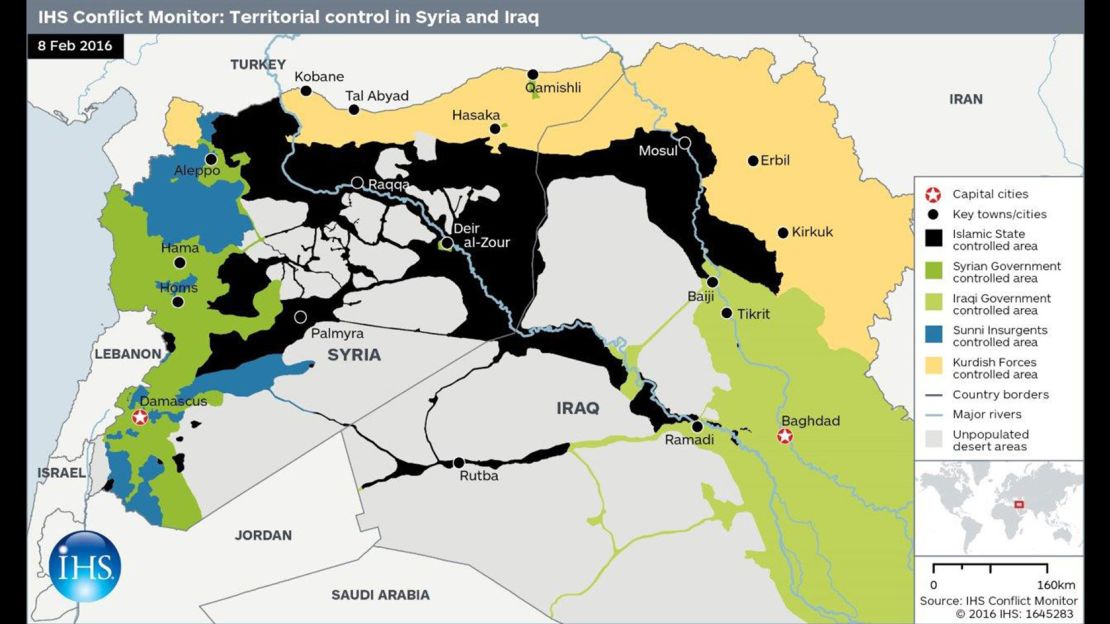The stakes are enormous. More than 250,000 people have died in Syria in the past five years. Half the country has been uprooted and fled. And unless drastic changes happen soon, the death and destruction will continue unabated.
Midnight Friday could be a game-changing point in the Syrian civil war. That’s when a “cessation of hostilities” is set to go into effect.
READ: Syria’s war: Everything you need to know about how we got here
Here are some questions and answers about the proposed peace plan:
What’s the difference between ‘cessation’ and ‘ceasefire’?
There are distinctions between a ceasefire, a cessation of hostilities and a truce. Unless you’re a peacekeeper or international lawyer, however, the differences aren’t that clear.
Colloquially, these terms are used interchangeably to describe an agreement to stop fighting. In international diplomacy, a ceasefire is more formal than a cessation of hostilities.
A cessation of hostilities implies a temporary halt in fighting, is usually nonbinding and commonly happens at the start of a peace process.
A ceasefire refers to a stoppage of violence that is tied to the framework of a peace process that is being negotiated.
The current deal in Syria is a cessation of hostilities.
Who does the cessation of hostilities apply to?
The text of the agreement calls for President Bashar al-Assad’s regime and the Syrian opposition groups to confirm by Friday at noon Damascus time that they intend to abide by the agreement.
There are other groups fighting inside Syria to whom the agreement does not apply. Terrorist groups, including ISIS and al-Nusra, are not included in the deal. Military operations against them will continue.

READ: How Syria war could turn on one strip of land
U.S. Secretary of State John Kerry said “a significant benefit” of the plan to cease hostilities is that it might “speed up the destruction” of ISIS.
Furthermore, “other terrorist organizations designated by the U.N. Security Council” are excluded from the cessation of hostilities. This is a small but important detail because there are more than 160 armed factions on the battlefield, and which of these groups fall under the umbrella of the “opposition” and which don’t is open to interpretation.
It is unclear whether the United Nations has a set list of terrorist organizations, or whether the debate continues.
What is the agreement?
In short, the cessation of hostilities calls for the Syrian regime and the opposition fighters to halt attacks and implement a U.N. “road map” for peace.
Under the terms of the agreement, Russia (whose warplanes have also targeted Syrian opposition groups) will halt those airstrikes.
Both sides agree to allow humanitarian agencies access to the territories they hold, and to refrain from taking territory held by the other side.
The “road map” is U.N. Security Council Resolution 2254, which the council adopted unanimously in December.
What will the peace process look like?
A key part of the agreement is full implementation of U.N. Security Council Resolution 2254, “including the readiness to participate in the U.N.-facilitated political negotiation process,” the document states.
This “road map” calls for a peace process where “the Syrian people will decide the future of Syria.”
The resolution calls for the government and the opposition to start formal negotiations on a political transition aimed at establishing a “a credible, inclusive and nonsectarian governance” in Syria.
The Security Council resolution foresees that a formal ceasefire, a new constitution and transparent elections will be among the results of the peace negotiations.
What’s at stake here?
It’s no exaggeration that the lives of millions of Syrians are at stake.
As the Syrian civil war enters its fifth year, some 13.5 million people are in dire need of protection and humanitarian assistance, according to Stephen O’Brien, the U.N. undersecretary-general for Humanitarian Affairs.
The dangers that Syrians face is not just from the violence (which has left more than 250,000 dead), but also from starvation and lack of medical services.
As of last week, U.N. and Red Crescent convoys had delivered 83 trucks of aid, reaching 61,000 people. But delays in delivering aid to areas that are under siege continue to hinder efforts.
“I cannot emphasize how high the stakes are at this moment in the conflict,” O’Brien said in a statement. “The Syrian people, who are rightly skeptical of the international community’s desire and ability to bring about an end to this hideous war after years of inaction – need to see an immediate difference in their daily lives on the ground because, up till this point, it is they who continue to bear the brunt of this crisis as violence has become more widespread, systematic and extreme.”
And at stake outside of Syria?
The civil war has become one of the biggest international crises in modern times. That the present agreement was brokered by the United States and Russia is meaningful, because visions over the future of Syria have raised tensions between the two powers.
The cessation of hostilities closely affects Syria’s neighbors, most notably Turkey.
Turkey, for decades, has been fighting a Kurdish separatist group – the Kurdistan Worker’s Party, of PKK. One of the groups fighting against ISIS inside Syria, the People’s Protection Units, or YPG, is a Kurdish group that Turkey considers a branch of the PKK. Turkey has bombed YPG positions inside Syria, and considers the YPG a terrorist group.
READ: The most dangerous group in Syria? It’s not ISIS
How will the fighting between these groups fit within the cessation of hostilities? The YPG has announced it will abide by the cessation of hostilities. And U.S. State Department spokesman Mark Toner said at a briefing that Turkey, as a member of the International Syria Support Group, is expected to buy into and abide by the cessation of hostilities.
Finally, European nations have a stake in the peace process as it will affect the flow of refugees fleeing war-torn Syria. The mass migration of refugees from Syria to Europe has become a crisis onto itself
What happens if they don’t adhere to the agreement?
Under the terms of the cessation of hostilities, the warring parties agree to use proportionate response in self-defense if and when attacked.
In other words, if one of the sides is attacked, its response should be no greater than what is required to stop the immediate threat.
What are the chances of this working?
We will have to wait and see.
Previous attempts at halting the violence have failed. As recently as this month, a group of world powers agreed on a date for cessation of hostilities. That date came and went.
“I could give you a million reasons to be skeptical,” Robert Malley, Obama’s top adviser on ISIS, told CNN’s Hala Gorani on Thursday. “Just look at the last five years that gives you ample reason to doubt what the regime will do, what Russian will do and what the allies will do. So we’re not going into this with a naive hope that it’s suddenly going to get much better. But we are going into this with the notion that we need to do everything we can to put the chances on our side that this does work – for the sake of the Syrian people first and foremost and for the sake of the fight against ISIL and regional stability.”
READ: Will Saudi Arabia be sucked in Syria bloodshed?
One difference with this effort, according to the U.S. State Department, is that this agreement has rules spelled out for how it will go into effect. Namely, both sides confirm by Friday at noon (Damascus time) that they are committed to the agreement, and then the cessation of hostilities take effect at midnight leading into Saturday.
“It has specific modalities on how this cessation of hostilities will look as it’s implemented on the ground, including monitoring and other aspects of how this thing will actually be implemented,” State Department spokesman Mark Toner said.
CNN’s Holly Yan contributed to this report.






















